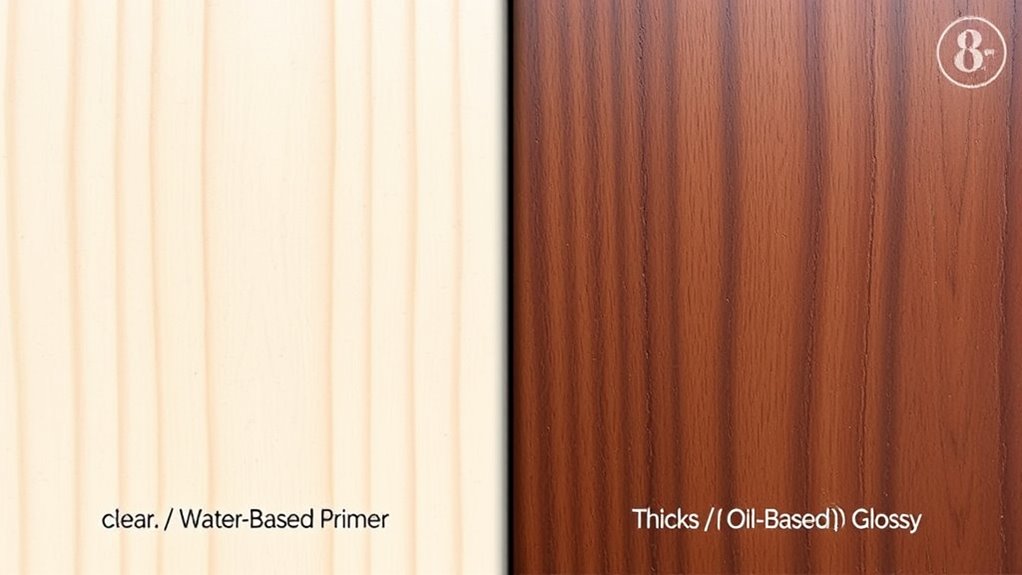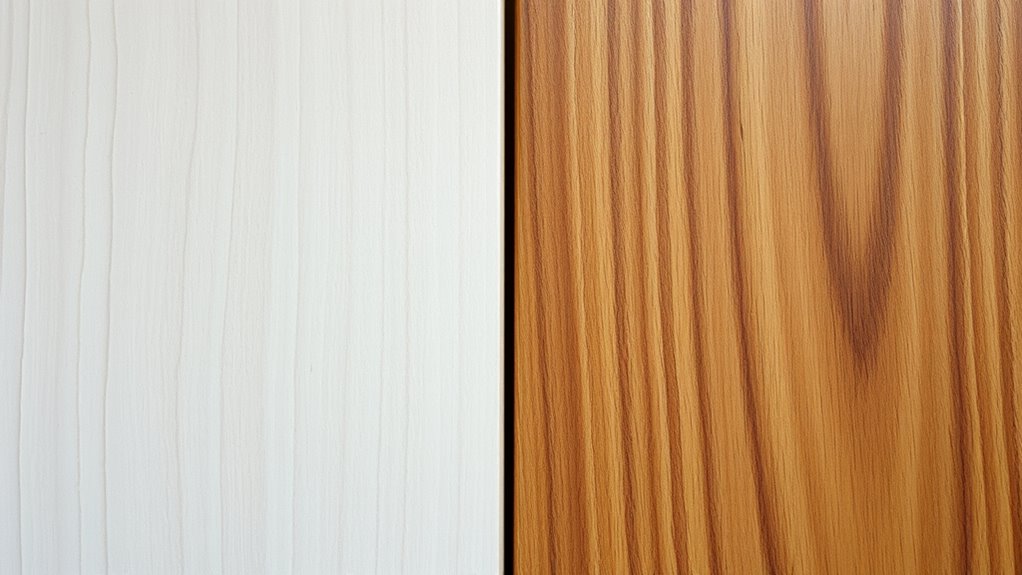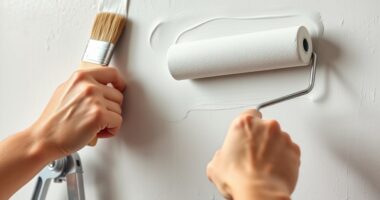When choosing between water-based and oil-based primers for different woods, consider the wood type and project location. Water-based primers work well for softwoods like pine or cedar indoors, offering quick drying and low odor. Oil-based primers are better for knotty or resinous woods and outdoor projects, providing stronger stain blocking and sealing. To get the best finish and durability, understanding these differences helps you pick the right primer. If you keep exploring, you’ll discover how to apply them perfectly for lasting results.
Key Takeaways
- Water-based primers are ideal for indoor projects and softwoods like pine or cedar, offering quick drying and low odor.
- Oil-based primers are better for knotty or resinous woods such as cedar or redwood, sealing oils and preventing stains.
- Consider wood characteristics and project location when choosing between water- or oil-based primers.
- Water-based primers are easier to apply, dry faster, and require less ventilation, suitable for quick indoor finishes.
- Oil-based primers provide better sealing on resinous woods but have longer drying times and stronger fumes.

Choosing the right primer is a crucial first step in ensuring a smooth and long-lasting paint job. When deciding between water-based and oil-based primers for different woods, understanding their application techniques and drying times can make all the difference. Your goal is a finish that not only looks great but also withstands the test of time, so selecting the appropriate primer and applying it correctly is essential.
If you’re working with softwoods like pine or cedar, a water-based primer is often your best choice. It’s easier to work with, dries quicker, and has low odor, making it suitable for indoor projects. When applying, use a high-quality brush or roller, and be sure to apply thin, even coats. Proper application techniques ensure the primer penetrates the wood evenly and minimizes drips or brush marks. Pay attention to the manufacturer’s recommended drying times—typically, water-based primers dry within 30 minutes to an hour. This quick drying allows you to move on to the next coat or topcoat sooner, saving you time and effort. Just remember, drying times can vary based on humidity and temperature, so always check the label for specific guidance.
On the other hand, oil-based primers work better for knotty or resinous woods, such as cedar or redwood, because they seal in oils and prevent stains from bleeding through your finish. These primers tend to have a longer drying time, often requiring 4 to 6 hours or even overnight before you can recoat. This longer drying time means you need to plan your project accordingly, especially if you’re working under tight deadlines. When applying oil-based primer, use a natural bristle brush or a roller suited for thicker coatings. Apply in smooth, even strokes to achieve a uniform layer. Since oil-based primers tend to be more viscous, they might require thinning with mineral spirits, especially if you’re using a roller. Proper application techniques are key here to avoid streaks or uneven coverage, which could affect the final look.
Frequently Asked Questions
Can Primers Be Tinted to Match the Wood Color?
Yes, primers can be tinted to match wood. A tinted primer acts as a base coat that helps achieve better color matching and coverage, especially when working with wood that has uneven or dark tones. By choosing a tinted primer designed for matching wood, you guarantee the final paint or stain looks smooth and uniform. Always tell your paint supplier your project needs so they can help you select the right tinted primer.
Are Water-Based Primers Suitable for Outdoor Wooden Furniture?
You know what they say, “a stitch in time saves nine,” and that’s true for outdoor wooden furniture. Water-based primers are suitable for outdoor protection if you choose a high-quality, weather-resistant type. They resist fading and cracking better than you might think, making them ideal for outdoor wooden furniture. Just guarantee you properly prep and seal your furniture afterward to keep it looking great for years.
How Long Should Primer Dry Before Applying Paint?
You should wait at least 1 to 2 hours for the primer to dry before applying paint, but always check the manufacturer’s instructions for precise drying time. Proper drying guarantees good adhesion and a smooth finish. During primer application, avoid touching or exposing it to moisture. Rushing the drying process can lead to peeling or uneven paint. Patience ensures your paint job looks professional and lasting.
Is There a Difference in Primer Smell Between Water-Based and Oil-Based?
The primer smell comparison is like night and day—water-based primers barely have an odor, almost like a whisper, while oil-based primers release a powerful, lingering smell that can knock you over. If you’re sensitive to strong smells, you’ll love how gentle water-based primers are. They’re perfect for a fresh, clean smell, whereas oil-based primers might leave you wishing you’d worn a gas mask!
Can Primers Be Used on Previously Painted or Stained Wood Surfaces?
Yes, you can use primers on previously painted or stained wood surfaces. Make sure to clean the surface thoroughly and lightly sand it to improve primer adhesion. Use a stain-blocking primer if there are stains or dark colors, and choose a compatible primer for existing paint or stain. This guarantees better adhesion, prevents bleed-through, and results in a smooth, durable finish.
Conclusion
So, choosing the right primer isn’t just a small decision—it’s your secret weapon for transforming even the dullest wood into a stunning masterpiece. Water-based primer is like a gentle rain, soaking in quickly and brightening your wood’s natural beauty. Oil-based primer, on the other hand, is a mighty shield, sealing and defending against the toughest stains and stains. Pick wisely, and watch your project become an awe-inspiring work of art that practically leaps off the surface!









